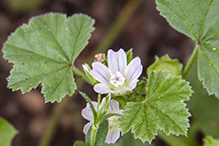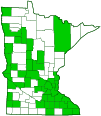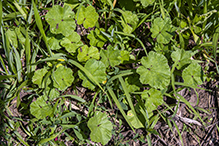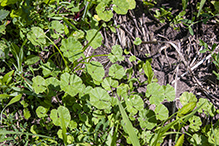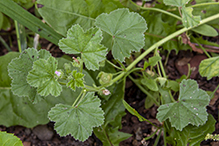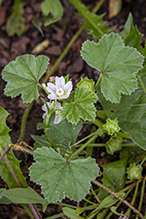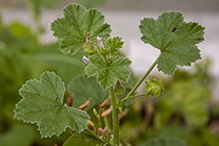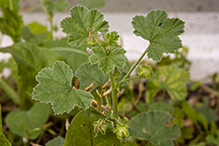common mallow
(Malva neglecta)
Conservation • Description • Habitat • Ecology • Use • Distribution • Taxonomy
Conservation Status |
|
|||||||
| IUCN Red List | not listed |
|||||||
| NatureServe | NNA - Not applicable SNA - Not applicable |
|||||||
| Minnesota | not listed |
|||||||
Description |
||
Common mallow, also called dwarf mallow, is an exotic, weedy, low-growing, herbaceous plant. It is native to Europe, Asia, and North Africa. This and several other species of Malva have been introduced into and are now naturalized in North America. Of these, Malva neglecta is by far the most common. It occurs throughout the United States but is uncommon in the southeast. It is common in Minnesota. It is found on the banks of rivers and streams; on the margins of ponds and lakes; on roadsides and railroads; in fields, pastures, lawns, and farmyards; and in other open, disturbed areas. Common mallow is an annual, biennial, or perennial forb that rises usually on several stems from a woody taproot. The stems may be branched or unbranched. When there are multiple stems, the outer stems are up to 40″ (1 m) long. They creep along the ground (prostrate) but do not root at the nodes. The inner stems are shorter, 8″ to 16″ (20 to 40 cm) long, sometimes longer, and curve upward from the base (ascending). All stems are sparsely covered with both unbranched (simple) and star-shaped (stellate) hairs. The simple hairs are relatively stout. The stellate hairs are branched at the base into three or more relatively fine, widely spread arms. The stellate hairs wear away with age but the simple hairs persist on older stems. The leaves are alternate, ⅝″ to 1⅜″ (15 to 35 mm) long, and ⅜″ to 1 9⁄16″ (10 to 40 mm) wide. The leaf stalks (petioles) are up to 7″ long, 2 to 5 times as long as the blade. At the base of each petiole there is a pair of small appendages (stipules). The stipules are papery, narrowly triangular, ⅛″ to ¼″ (3 to 6 mm) long, and ⅛″ (2.5 mm) wide. They are persistent throughout the growing season. The leaf blades are kidney-shaped or heart-shaped to almost round. They usually have 5 to 7 broad, shallow lobes. They may be flat or slightly wavy and 3-dimensional (crisped) near the margins. The upper and lower surfaces may be hairless or sparsely covered with stellate hairs, especially at the base. The margins are shallowly scalloped (crenate) to sharply toothed with outward-pointing teeth (dentate). The inflorescence is a cluster of 2 to 6 flowers on long stalks (pedicels) in the leaf axils. When in flower, the pedicels are ascending and several times longer than the whorl of floral leaves at the base of the flower (calyx). When in fruit, the pedicels are drooping, flexible, and curved upward at the tip. At the base of each flower there are 5 small modified leaves (bractlets). The bractlets are linear to narrowly oblong, ⅛″ to 3⁄16″ (3 to 1 mm) long, and 1⁄32″ (1 mm) wide, shorter than the calyx. Each flower is ½″ to 1″ wide. There are 5 outer floral leaves (sepals, together the calyx), 5 petals, numerous stamens, and 1 pistil. When in flower, the calyx is green, cup shaped, and ⅛″ to ¼″ (4 to 7 mm) long. When in fruit it flattens out and slightly expands to 5⁄16″ (8 mm) long. The lobes are triangular and remain green and herbaceous. They do not have a distinct network of veins. The outer surface is is covered with stellate hairs, and the margin has a fringe of short hairs. The petals are pale violet to white, notched at the tip, and ⅜″ to ½″ (9 to 13 mm) long, about twice as long as the calyx. The veins are not dark but there is often a bold dark streak in the middle and one or two faint streaks on each side. The stalks (filaments) of the stamens are fused for most of their length around the pistil forming a round in cross section reproductive column. The anthers are white. The fruit is a wheel-shaped, ¼″ in diameter arrangement (schizocarp) of 12 to 15 one-seeded carpels (mericarps). It resembles a tiny wheel of cheese. This is the feature that gives the plant one of its common names, “cheeseweed”. Each mericarp is 1⁄16″ (1.5 to 2.0 mm) long, smooth or weakly ridged, hairy on the back, and rounded on the outer edge. |
||
Height |
||
8″ to 16″ |
||
Flower Color |
||
Pale violet to white |
||
Similar Species |
||
Habitat |
||
Riverbanks, streambanks, pond and lake margins, roadsides, railroads, fields, pastures, lawns, farmyards, and in other open, disturbed areas |
||
Ecology |
||
Flowering |
||
June to October |
||
Pests and Diseases |
||
Hollyhock Rust (Puccinia malvacearum) |
||
Use |
||
|
||
Distribution |
||||
|
Sources |
|||
| 3/29/2023 | ||||
Nativity |
||||
Native to Europe, Asia, North Africa, and the Indian subcontinent. Introduced and naturalized in North America. |
||||
Occurrence |
||||
Common in Minnesota |
||||
Taxonomy |
|||
| Kingdom | Plantae (Plants) | ||
| Division | Tracheophyta (Vascular Plants) | ||
| Subdivision | Spermatophytina (Seed Plants) | ||
| Class | Magnoliopsida (Dicots) | ||
Order |
Malvales (mallows, rock-roses, and allies) | ||
Family |
Malvaceae (mallow and hibiscus) | ||
| Subfamily | Malvoideae | ||
| Tribe | Malveae | ||
| Genus | Malva (mallows) | ||
Malva neglecta was formerly included, along with Malva pusilla and other species, within Malva rotundifolia. The latter name is no longer used. |
|||
Subordinate Taxa |
|||
|
|||
Synonyms |
|||
Malva rotundifolia |
|||
Common Names |
|||
buttonweed cheeseplant cheeseweed common mallow dwarf mallow roundleaf mallow |
|||
Glossary
Ascending
Growing upward at an angle or curving upward from the base.
Axil
The upper angle where a branch, stem, leaf stalk, or vein diverges.
Bractlet
A small, often secondary bract within an inflorescence; a bract that is borne on a petiole instead of subtending it; bracteole.
Calyx
The group of outer floral leaves (sepals) below the petals, occasionally forming a tube. Plural: calyces.
Carpel
The female reproductive organ of a flower, consisting of an ovary, styles, and stigmas.
Filament
On plants: The thread-like stalk of a stamen which supports the anther. On Lepidoptera: One of a pair of long, thin, fleshy extensions extending from the thorax, and sometimes also from the abdomen, of a caterpillar.
Linear
Long, straight, and narrow, with more or less parallel sides, like a blade of grass.
Mericarp
The split, usually one-seeded portion of a dry, multi-seeded fruit.
Node
The small swelling of the stem from which one or more leaves, branches, or buds originate.
Pedicel
On plants: the stalk of a single flower in a cluster of flowers. On insects: the second segment of the antennae. On Hymenoptera and Araneae: the narrow stalk connecting the thorax to the abdomen: the preferred term is petiole.
Petiole
On plants: The stalk of a leaf blade or a compound leaf that attaches it to the stem. On ants and wasps: The constricted first one or two segments of the rear part of the body.
Prostrate
Laying flat on the ground.
Schizocarp
A dry fruit formed from a compound ovary that splits into two or more parts (mericarps) at maturity.
Sepal
An outer floral leaf, usually green but sometimes colored, at the base of a flower.
Stellate
Star-shaped. Stellate hairs have several or many branches radiating from the base.
Stipule
A small, leaf-like, scale-like, glandular, or rarely spiny appendage found at the base of a leaf stalk, usually occurring in pairs and usually dropping soon.

Slideshows |
||

Visitor Videos |
|||
Share your video of this plant. |
|||
| This button not working for you? Simply email us at info@MinnesotaSeasons.com. Attach a video, a YouTube link, or a cloud storage link. |
|||
Other Videos |
|||
| COMMON MALLOW (Malva neglecta) BYUI Applied Plant Science Department |
|||
About
Sep 6, 2019 How to identify Common Mallow (Malva neglecta) This plant is common mallow, a member of the mallow family that is native to Europe and which has become common around much of the world. It can grow as an annual, winter annual, or biennial, and flowers throughout the summer. The plant has branched, low-lying stems that sprawl outward. The stems are smooth and green with a purplish coloring. The leaves have long, thin petioles, and are somewhat heart-shaped with 5 to 7 light lobes. The leaves are wavy, roughly textured and widely serrated along their margins. They are dark green and may have purple veins, and have a covering of hairs on bother their upper and lower surfaces. The flowers are colored white to lavender, and often colored streaks that range from pink to blue. The flowers appear singly from the leaf axils. After pollination, they will produce round wheel-shaped fruits with the seeds arranged around the center. The plant has a large, woody taproot that reaches deep into the ground and s very resilient. It only reproduces via seed. Common mallow prefers well-drained, dry soils and some shade, but will grow wherever there is disturbed soil. It is common in fields, gardens, and cultivated crop areas. This plant is edible. Sources: Weeds of the West, 5th Edition (1991) by Tom D. Whitson, published by the Western Society of Weed Science University of California Agriculture and Natural Resources IPM – Weed Gallery http://ipm.ucanr.edu/ United States Department of Agriculture – Plant Database https://plants.usda.gov |
|||
| How to Identify Cheeseweed - Colorado Botany - Malva neglecta Colorado Botany |
|||
About
Aug 13, 2016 Cheeseweed – Malva neglecta – A weed related to Hollyhocks and Hibiscus that grows in disturbed areas. The common name, Cheeseweed, refers to the fruit which looks like a wheel of cheese. Learn how to identify Cheeseweed in this Colorado Botany video. |
|||
| Identifying Common Mallow EdibleWildFood.com |
|||
About
Jun 30, 2019 Common mallow (Malva neglecta) is easy to identify, with round fruits that exhibit cheese-like wedges. There is usually lots of it (depending on where you are). For more info see the links below. Common Mallow (identification, distinguishing features, flowers, leaves, height, habitat & edible parts): https://www.ediblewildfood.com/mallow.aspx. Root Harvesting in Autumn https://www.ediblewildfood.com/blog/2018/09/root-harvesting-in-autumn/ #commonmallow #cheeseweed #Malvaneglecta |
|||

Visitor Sightings |
|||||
Report a sighting of this plant. |
|||||
| This button not working for you? Simply email us at info@MinnesotaSeasons.com. Be sure to include a location. |
|||||
|
|||||
MinnesotaSeasons.com Sightings |
|||||
Lakeville, MN |
|||||

Created: 2/10/2021
Last Updated:
